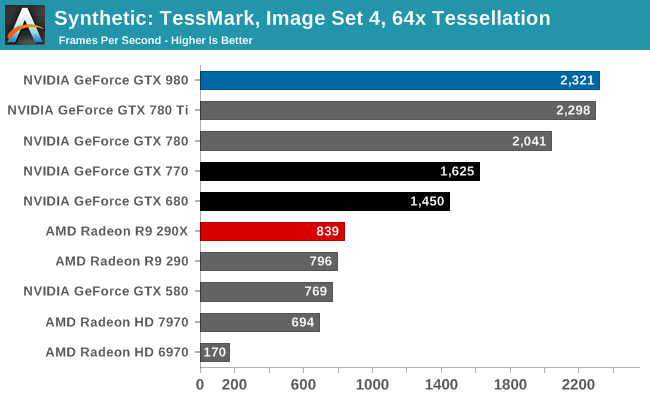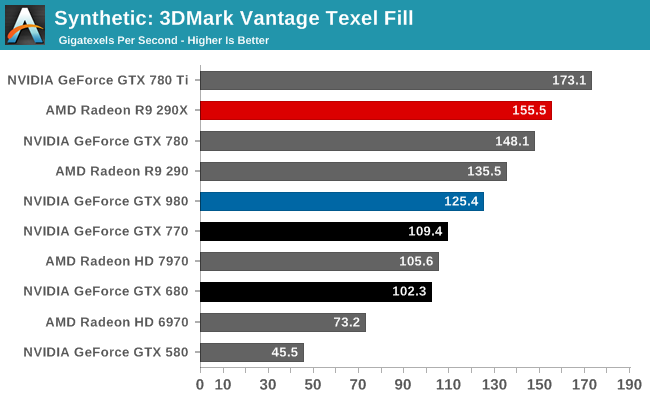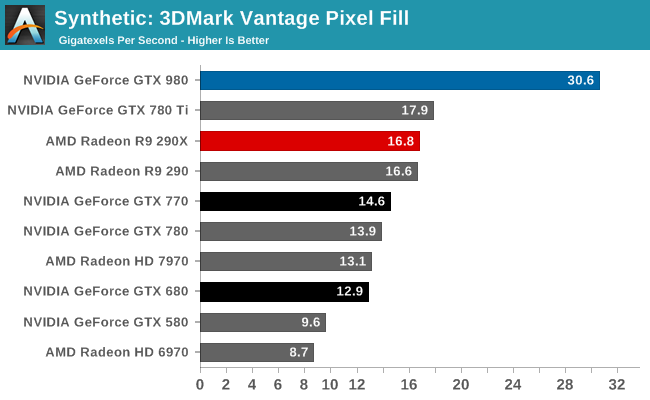The NVIDIA GeForce GTX 980 Review: Maxwell Mark 2
by Ryan Smith on September 18, 2014 10:30 PM ESTSynthetics
As always we’ll also take a quick look at synthetic performance. These tests mainly serve as a canary for finding important architectural changes, and with the exception of pixel throughput we are not expecting any major changes for GTX 980 and GM204.

GM204 is designed to have an ever-so-slightly higher triangle throughput rate than GK110 – 16 tris/clock versus 15 tris/clock, and sure enough the GTX 980 comes out on top in TessMark, slightly edging out the GTX 780 Ti. The difference is only very slight here, and though GM204 should be a bit more powerful than GK110 in practice it’s a dead heat.
Moving on, we have our 3DMark Vantage texture and pixel fillrate tests, which present our cards with massive amounts of texturing and color blending work. These aren’t results we suggest comparing across different vendors, but they’re good for tracking improvements and changes within a single product family.

Beginning with Maxwell NVIDIA reduced their texture-to-compute ratio from 12:1 to 16:1. As a result of this change Maxwell GPUs have fewer texture units than comparable Kepler GPUs. Compounding this effect is the fact that Maxwell CUDA cores are more efficient than Kepler CUDA cores, leading to NVIDIA placing fewer cores overall and further reducing the texture fill rate.
As a result the GTX 980 is not texture fillrate competitive with any of the GK110 cards. It is competitive with the GK104 cards, but only because these cards had the same number of texture units at 128. NVIDIA has told us that they believe this new ratio is a better fit for modern workloads, and judging from the performance we’re seeing elsewhere it would appear that NVIDIA is right.

On the other hand, thanks to NVIDIA’s newer 3rd generation delta color compression technology, our 3DMark pixel fillrate performance is through the roof. GTX 980 comes very close to doubling the throughput of our GK110 cards and more than doubles the throughput of the GK104 cards, reflecting the fact that it has 64 ROPs and more importantly has the available bandwidth to put them to good use.
This benchmark in a nutshell is why NVIDIA can deliver chart-topping performance despite having only 2/3rds the memory bandwidth of GTX 780 Ti. By improving their color compression to this point, NVIDIA can significantly reduce their memory bandwidth requirements Maxwell 2, allowing them to do more with less. In real games the result won’t be anywhere near this remarkable since this is a pure pixel fillrate test, but it goes to show that NVIDIA has been able to expand their effective memory bandwidth in concert with their ROP and shader performance improvements.










274 Comments
View All Comments
CrystalBay - Friday, September 19, 2014 - link
Are these parts going to be full DX12 compliant ?extide - Friday, September 19, 2014 - link
Noarbit3r - Friday, September 19, 2014 - link
yes, it says it is.rahvin - Friday, September 19, 2014 - link
14nm is the first process node since they started building IC's that costs more than the prior generation. It would appear that the days of continually dropping prices are gone if this remains true. People really fail to realize how significant this is and it's likely to have profound impacts on the industry for the foreseeable future. It's quite possible that process advances will slow down dramatically as a result of the higher costs because the producers are no longer guaranteed a lower priced product for the same input. Continually improving products at lower prices may be a thing of the past in the CPU space.vailr - Friday, September 19, 2014 - link
Will there also later be a Maxwell GPU successor to nVidia's GTX 760?extide - Friday, September 19, 2014 - link
Yes, of coursemartixy - Friday, September 19, 2014 - link
The universe is oddly self-correcting when it comes to those types of things. The hiccup in the process node seemingly comes at just the right time, to kick designer's asses into letting go of that mad dash for transistors and focus on intelligent and efficient design instead.Vinny DePaul - Friday, September 19, 2014 - link
Does it mean it is time for me to sell my GTX 770 and buy GTX 970?wolfman3k5 - Friday, September 19, 2014 - link
Why would anyone buy your GTX 770 when they could easily be buying a GTX 970 now?!Laststop311 - Friday, September 19, 2014 - link
Vinny that depends. If you are gaming at 1080 res there is no point. At 1440 it would depend on the game but for the most part the 770 is still fine. I don't think you should waste your money but to each his own.